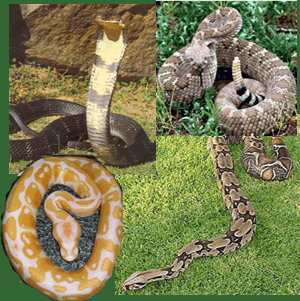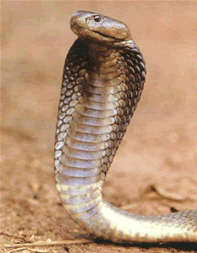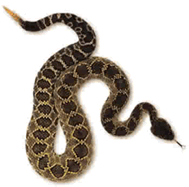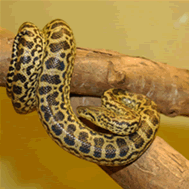There are over 3,000 different snake species in the world. Click on a snake in the picture below to learn more about that species.


The python is a fairly slender snake that coils around tree branches. Generally, they are a vibrant green in color but some adults are blue or yellow. Some say that the vibrant green color and the coiled shape resembles bananas hanging in the tree. They can grow to lengths of 2.1 metres. Pythons generally sleep during the day and come out at night. They are very good to sense temperature change. An example would be if a warm blooded animal came within range, the python would be able to notice the temperature change. The same would be true if a cold blooded animal came within range. They like to live in humid, warm and tropical regions. They are endangered in their native countries due to habitat destruction, skin trade, and hunting for food. A pythons diet would mainly consist of small rodents, rabbits and birds

A king cobra has a head as big as a man’s hand and it can stand tall enough to look you straight in the eye. The king cobra’s deadly fangs are almost half an inch long. A king cobra’s venom is actually less lethal than a common cobra’s. It more than makes up for it by delivering more venom per bite. That’s enough to kill an elephant, or 20 people. Its venom can stun your nervous system and stop your breathing. The king cobra can sleep with its eyes open. By flicking its tongue, a snake brings odours in to ‘nostrils’ inside the mouth. The king cobra is also a snake eater. King cobras prefer snakes like the rat snake, but they also dine on venomous Indian cobras, kraits, and even small king cobras, thus earning the title, ‘cannibal.’

Rattlesnakes are a group of venomous snakes , which receive their name for the rattle located at the tip of their tails. The rattle is used as a warning device when threatened. The rattle is composed of a series of nested, hollow beads which are actually modified scales from the tail tip. Adult snakes may lose their rattles and if the rattle absorbs enough water in wet weather, it will not make noise. There are approximately fifty different species of rattlesnake . Rattlesnakes are born with fully functioning fangs capable of injecting venom and can regulate the amount of venom they inject when biting. Generally they deliver a full dose of venom to their prey, but may deliver less venom or none at all when biting defensively. Rattlesnakes eat rodents and other small animals, such as rabbits, rats and mice. They kill their prey with a quick venomous bite. Rattlesnakes may shed their skins several times a year depending on food supply and growth rates.

The anaconda is the largest known snake in the world. People have reported seeing anacondas as long as 45 metres The anaconda lives in Central and tropical South America. They are usually found in swamps and rivers. It is a member of the Boa family of snakes and is dark green in colour with round markings. It is sometimes referred to as the "water boa." While some snakes use venom to kill or their victims, the anaconda, kill by constriction. By looping its body around an animal, it can use its powerful muscles to squeeze until the animal can no longer breath. The large anacondas feed on deer, pigs, caiman (a creature that looks like a small crocodile), and fish. The snake usually wraps his extended jaws around the head of the victim and swallows working its way down to the victim's feet.